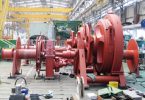- Stop the circulating oil pump. Take off/open all the lowermost doors on one side of the crankcase. Cut off the starting air, and engage the turning gear.
- Locate the “hot spot”. Use powerful lamps from the start.
- Feel over, by hand or with a “thermo feel”, all the sliding surfaces (bearings, thrust bearing, piston rods, stuffing boxes, Crossheads, telescopic pipes, chains, vibration dampers, moment compensators, etc.).
- Look for Squeezed-out bearing metal, and discolouration caused by heat (blistered paint, burnt oil, oxidized steel). Keep possible bearing metal found at bottom of oil tray for later analyzing.
- Prevent further “hot spots” by prefer ably making a permanent repair. In case of bearing running hot,
- Ensure that the respective sliding surfaces are in good condition.
- Take special care to check that the circulating oil supply is in order.
- Start the circulating oil pump and turn the engine by means of the turning gear.
- Check the oil flow from all bearings, spray pipes and spray nozzles in the crankcase, chain case and thrust bearing.
- Check for possible leakages from pistons or piston rods.
- Start the engine.After:
- 15-30 minutes,
- One hour later,
- when full load is reached:
- Stop and feel over, Look for oil mist.anan
- Especially feel over (by hand or with a “thermo-feel”) the sliding surfaces which caused the overheating.
- In cases where it has not been possible to locate the “hot spot”, the procedure should be repeated and intensified until the cause of the oil mist has been found and remedied.
- There is a possibility that the oil mist is due to “atomization” of the circulating oil, caused by a jet of air/gas, e.g. by combination of the following:
- Stuffing box leakages (not air tight).
- Blow-by through a cracked piston crown or piston rod (With direct connection to crankcase via the cooling oil outlet pipe).
- An oil mist could also develop as a result of heat from a scavenge fire being transmitted down the piston rod or via the stuffing box. Hot air jets or flames could also have passed through the stuffing box into the Crankcase.


